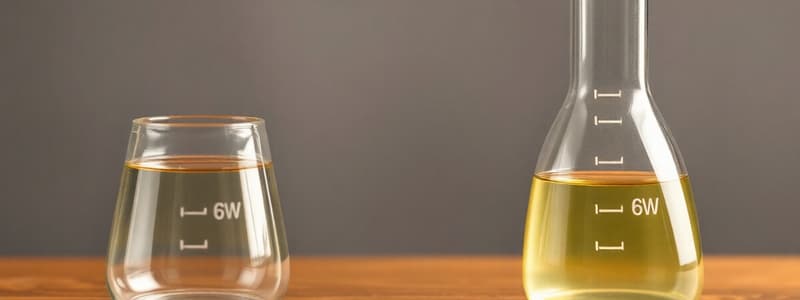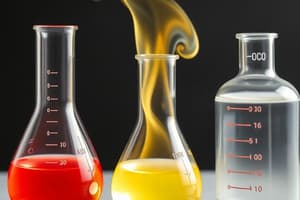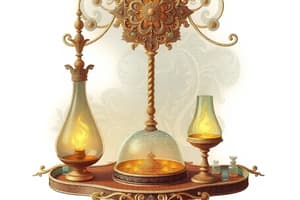Podcast
Questions and Answers
According to Boyle's Law, if the pressure exerted on a gas increases while temperature and mass remain constant, what change will be observed in the volume of the gas?
According to Boyle's Law, if the pressure exerted on a gas increases while temperature and mass remain constant, what change will be observed in the volume of the gas?
- The volume will fluctuate irregularly.
- The volume will remain constant.
- The volume will increase.
- The volume will decrease. (correct)
Charles' Law describes the relationship between which two variables of a gas, assuming constant pressure and mass?
Charles' Law describes the relationship between which two variables of a gas, assuming constant pressure and mass?
- Temperature and pressure
- Volume and temperature (correct)
- Mass and volume
- Pressure and volume
According to Gay-Lussac's Law, what happens to the pressure of a gas if the temperature increases while volume and mass are kept constant?
According to Gay-Lussac's Law, what happens to the pressure of a gas if the temperature increases while volume and mass are kept constant?
- The pressure increases. (correct)
- The pressure fluctuates unpredictably.
- The pressure decreases.
- The pressure remains constant.
The Combined Gas Law is useful for scenarios that involve changes in which of the following gas properties?
The Combined Gas Law is useful for scenarios that involve changes in which of the following gas properties?
What does Dalton's Law of Partial Pressures state regarding the total pressure of a gas mixture?
What does Dalton's Law of Partial Pressures state regarding the total pressure of a gas mixture?
Why might a real gas deviate from behaving ideally, as described by the Ideal Gas Law?
Why might a real gas deviate from behaving ideally, as described by the Ideal Gas Law?
In the context of respiratory gases, what causes the change in gas composition from tracheal air to alveolar air?
In the context of respiratory gases, what causes the change in gas composition from tracheal air to alveolar air?
Avogadro's Law states that at the same temperature and pressure, equal volumes of different gases contain the same number of what?
Avogadro's Law states that at the same temperature and pressure, equal volumes of different gases contain the same number of what?
Which set of conditions is associated with 'STPD' when converting gas volumes?
Which set of conditions is associated with 'STPD' when converting gas volumes?
Which adjustment accounts for the pressure exerted by water vapor when applying Dalton's Law to respiratory gases in the lungs?
Which adjustment accounts for the pressure exerted by water vapor when applying Dalton's Law to respiratory gases in the lungs?
What is the key factor that differentiates the application of the ideal gas law from the combined gas law?
What is the key factor that differentiates the application of the ideal gas law from the combined gas law?
Why is it necessary to convert temperature to Kelvin when using Charles' Law or Gay-Lussac's Law?
Why is it necessary to convert temperature to Kelvin when using Charles' Law or Gay-Lussac's Law?
Under what circumstances is the use of the Ideal Gas Law most appropriate?
Under what circumstances is the use of the Ideal Gas Law most appropriate?
In the Ideal Gas Law equation, PV = nRT, what does 'n' represent?
In the Ideal Gas Law equation, PV = nRT, what does 'n' represent?
Which of the following is a direct application of Dalton's Law of Partial Pressures in respiratory physiology?
Which of the following is a direct application of Dalton's Law of Partial Pressures in respiratory physiology?
How does considering water vapor pressure affect the calculation of partial pressures of other gases in a mixture, particularly in the context of respiratory physiology?
How does considering water vapor pressure affect the calculation of partial pressures of other gases in a mixture, particularly in the context of respiratory physiology?
What is the significance of Avogadro's number in the context of gas laws?
What is the significance of Avogadro's number in the context of gas laws?
According to Boyle’s Law, if the initial pressure and volume of a gas are $P_1$ and $V_1$ respectively, what will the new volume ($V_2$) be if the pressure changes to $P_2$, assuming constant temperature and number of moles?
According to Boyle’s Law, if the initial pressure and volume of a gas are $P_1$ and $V_1$ respectively, what will the new volume ($V_2$) be if the pressure changes to $P_2$, assuming constant temperature and number of moles?
If a container of gas at 27°C is heated to 227°C, what effect will this have on the volume of the gas, assuming the pressure remains constant?
If a container of gas at 27°C is heated to 227°C, what effect will this have on the volume of the gas, assuming the pressure remains constant?
If a balloon contains 10L of air at standard temperature and pressure (STP), approximately how many moles of air are in the balloon, given that R = 0.0821 L atm / (mol K)?
If a balloon contains 10L of air at standard temperature and pressure (STP), approximately how many moles of air are in the balloon, given that R = 0.0821 L atm / (mol K)?
Flashcards
Boyle's Law
Boyle's Law
Volume and Pressure are inversely proportional when temperature and mass are constant.
Charles' Law
Charles' Law
For a given mass of gas, volume varies directly with absolute temperature when pressure is constant.
Gay-Lussac's Law
Gay-Lussac's Law
For a given mass of gas, pressure varies directly with absolute temperature when volume remains constant.
Dalton's Law of Partial Pressure
Dalton's Law of Partial Pressure
Signup and view all the flashcards
Combined Gas Law
Combined Gas Law
Signup and view all the flashcards
Avogadro's Law
Avogadro's Law
Signup and view all the flashcards
Ideal Gas Law
Ideal Gas Law
Signup and view all the flashcards
Study Notes
- Gas laws are examined.
Introduction to Gas Laws
- Gas behavior depends on temperature, pressure, and volume.
- Mass (amount of gas) remains constant, denoted as k.
- Gases do not typically behave ideally under all conditions of temperature and pressure.
- Pressure and temperature must not reach the point where the gas changes state for ideal behavior.
Boyle's Law
- For a fixed mass of gas, volume (V) and pressure (P) are inversely proportional when temperature (T) and mass are constant.
- Expressed as P x V = k.
- When pressure goes up, volume goes down.
- When pressure goes down, volume goes up.
Charles' Law
- For a given mass of gas, the volume varies directly with the absolute temperature when the pressure is constant.
- Temperature must be in Kelvin.
- V/T = k
- When temperature goes up, volume will go up.
- When temperature goes down, volume will go down.
Gay-Lussac's Law
- For a given mass of gas, the pressure varies directly with the absolute temperature when the volume remains constant.
- P/T = k
- When temperature goes up, pressure goes up.
- When temperature goes down, pressure goes down.
Constants
- "Boyle is boiling mad, because poor Charles is under so much pressure, because of Gay-Lussac's radio's volume is up so high." helps memorization.
- "Liquor Control Board" relates to the combined gas law.
Dalton's Law of Partial Pressure
-
The sum of each of the gases in a mixture equals the barometric pressure of that gas.
-
The partial pressure of a gas is equal to the concentration x the barometric pressure [Pb].
-
When applied to atmospheric air in the lungs: PB = P02 + PC02 + PN2 + PH20.
-
Examples of partial pressures in atmospheric air:
- O2: 20.9 kPa, 3.03 psi, 21%
- N2: 78.1 kPa, 11.32 psi, 78%
- Ar: 0.97 kPa, 0.14 psi
- H2O: 1.28 kPa, 0.18 psi, 47 mm Hg
- CO2: 0.05 kPa, 0.007 psi, 0.05%, 760 mm Hg
Dry Atmospheric Air & Air Containing Water Vapor Pressure
- Converting gas percentages to partial pressure.
- Correction for PH2O.
- PB – PH2O follows Dalton’s law and allows for pressure of gases.
Tracheal Air vs. Alveolar Air
- As gas travels from the trachea to the carina to the alveoli, it changes due to oxygen uptake and carbon dioxide removal at the alveolar-capillary membrane caused by O2 and CO2 pressure gradients.
- BTPS (Body Temperature Saturated) is at 47 mmHg.
- ATPS (Atmosphere Temperature Pressure Saturated).
Combined Gas Law
- Incorporates the pressure, volume, and temperature of a fixed mass of gas.
- (P x V) / T = k, and (P1 x V1) / T1 = (P2 x V2) / T2.
- Allows for calculation of gas volume conversion:
- From Atmosphere Temperature, Pressure, Saturated (ATPS) to Standard Temperature (0 °C) Pressure (760 torr) Dry (STPD) (0 torr PH20).
- From ATPS to Body Temperature, Pressure, Saturated (BTPS) (37 °C at 47 torr).
- From STPD to BTPS.
Convert Gas Volume: STPD to BTPS
- P1 = 750 mmHg, P2 = 760 mmHg
- T1 = 273 K, T2 = 310 K
- PH2O = 0 mmHg, PH2O = 47 mmHg
- Conversion factor is approximately 1.2
Ideal Gas Law
- PV = nRT
- n = number of moles of gas
- R = universal gas (Boltzmann's) constant (82.1 atm ml/mol. K, or 8.31 Pa.m3 / mol. K).
- If the amount of gas remains constant (nR), it can be used to predict changes of temperature (K), pressure, and volume.
Ideal Gas Equation
- It does not reflect the real relationship of gas molecules but only under "ideal" conditions.
- "Ideal" conditions for the ideal gas law are under high temperature and low pressure.
- Deviations from ideal behavior: Volume and Van der Waals forces
Avogadro's Law
- At equal temperatures and pressures, equal volumes of different gases, regardless of their mass, contain equal numbers of molecules.
- Avogadro's number represents the number of molecules in 1 GMW of a substance.
- N = kV
Studying That Suits You
Use AI to generate personalized quizzes and flashcards to suit your learning preferences.




